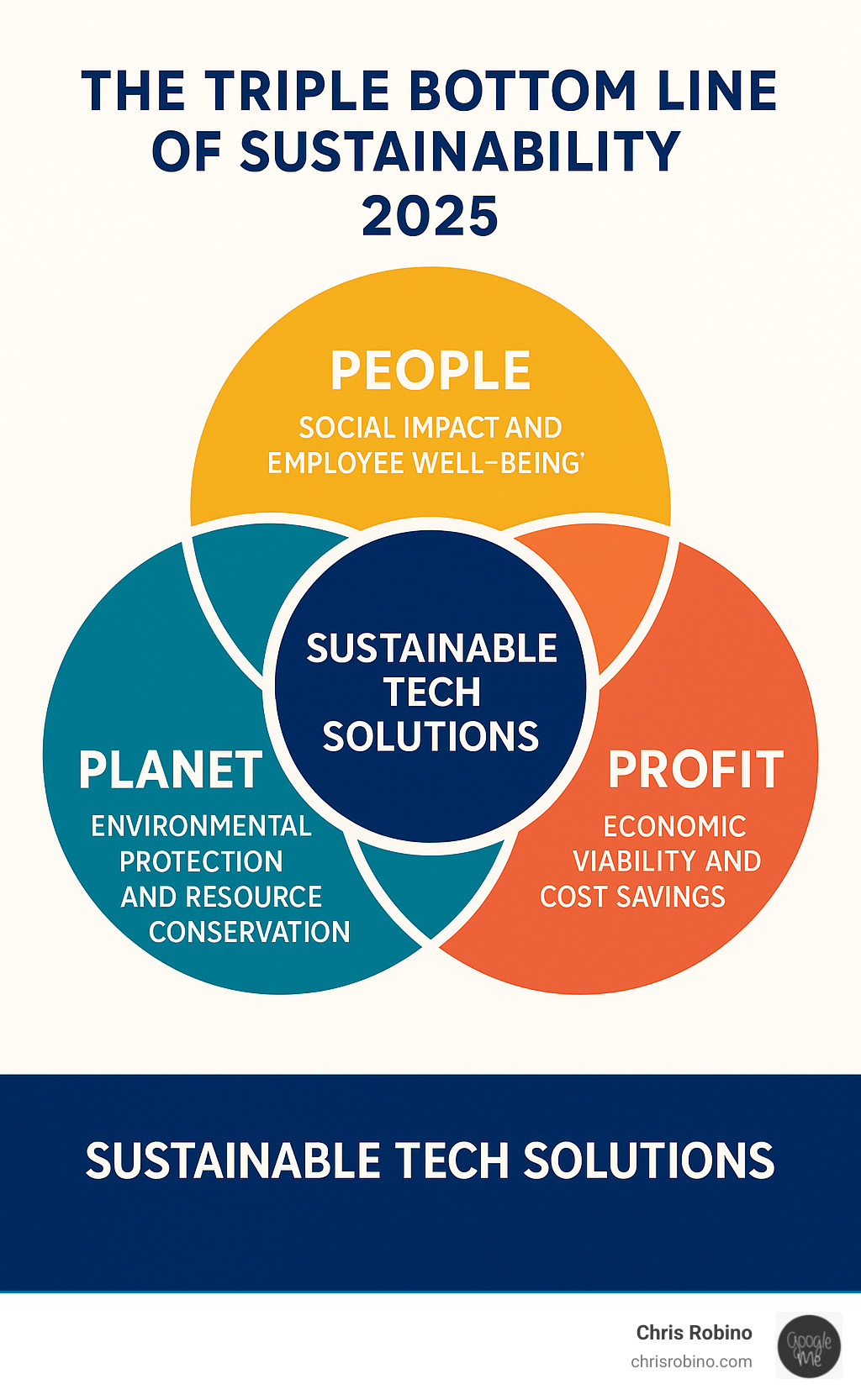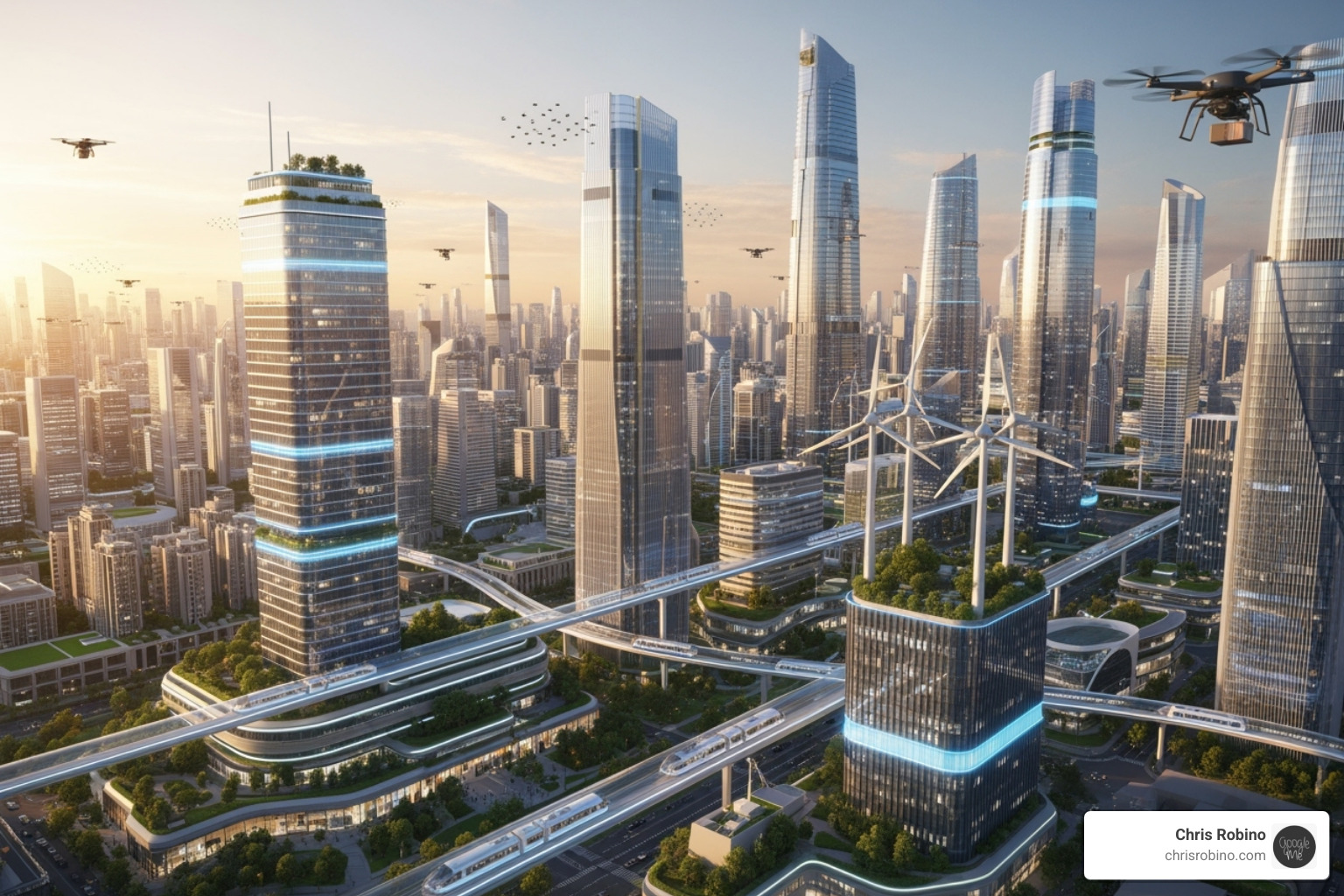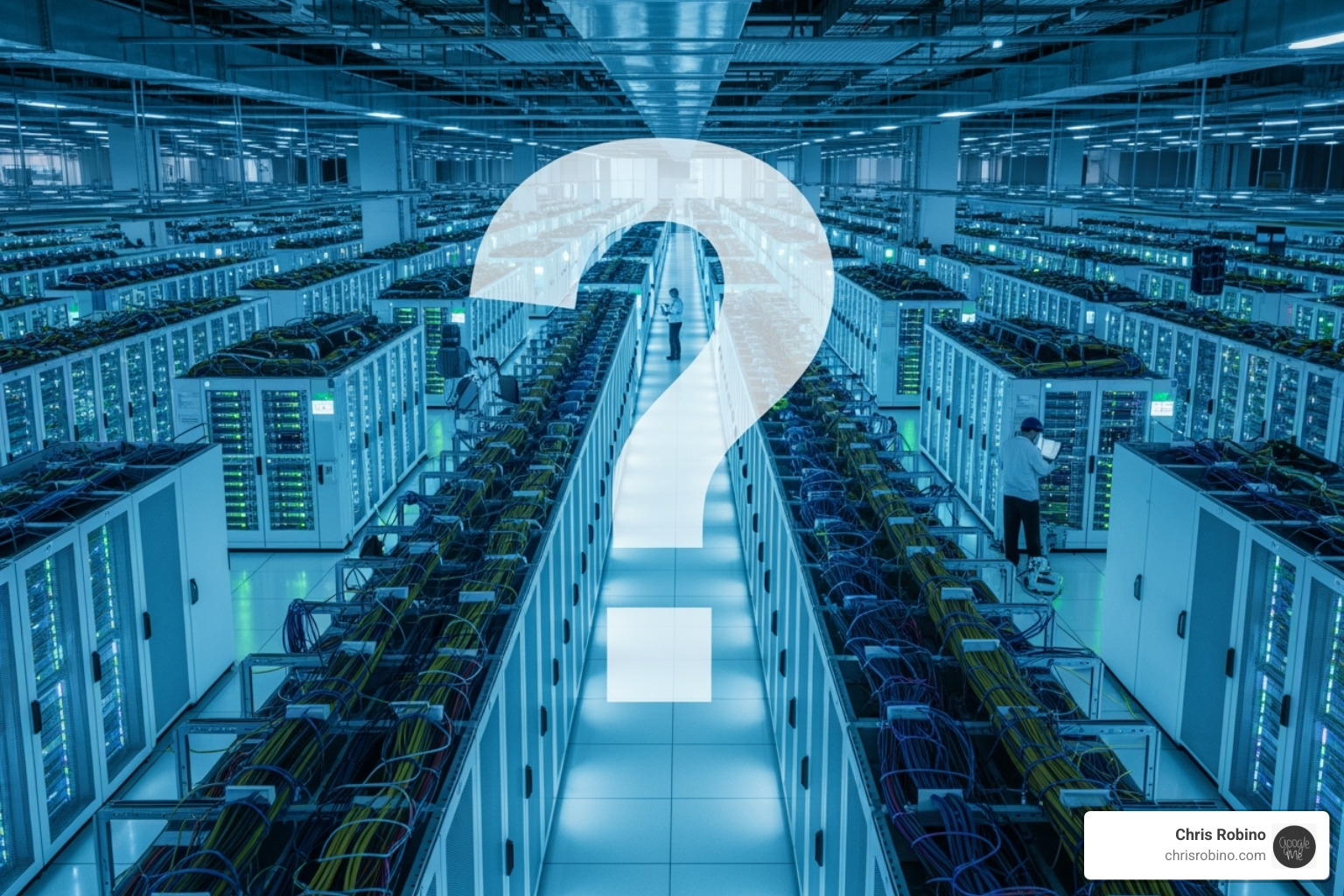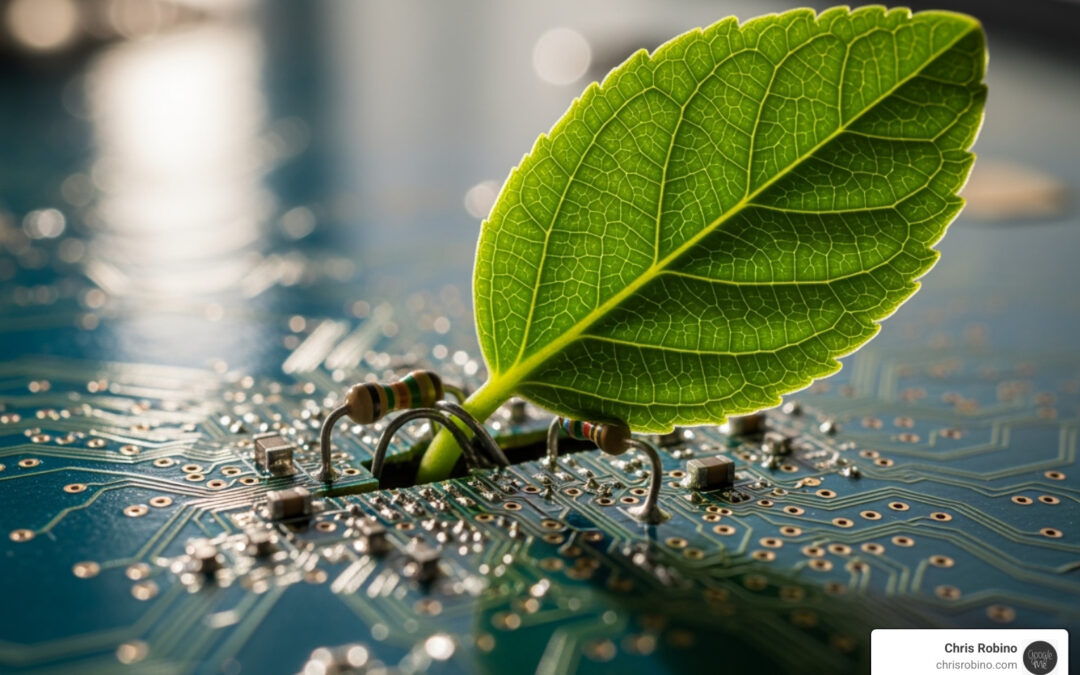What is Sustainable Technology and Why Does it Matter?
Sustainable tech solutions are technologies designed to minimize environmental impact while meeting business needs through efficient resource use, renewable energy integration, and circular economy principles. These solutions address three key areas: reducing carbon footprints, optimizing operational efficiency, and supporting long-term environmental goals.
Key Types of Sustainable Tech Solutions:
- Renewable Energy Systems – Solar panels, wind power, hydrogen fuel cells
- AI and IoT Optimization – Smart grids, predictive analytics, resource management
- Green IT Infrastructure – Cloud computing, data center efficiency, sustainable software
- Circular Economy Tech – Advanced recycling, waste reduction, right-to-repair solutions
- Smart Building Systems – LED lighting, automated climate control, energy monitoring
The global sustainable technology market was valued at $9 billion in 2019 and is projected to reach $48.36 billion by 2027 – a growth rate of 24.3%. This isn’t just about saving the planet anymore. It’s about saving money, attracting talent, and staying competitive.
Modern businesses face a dual challenge: they need technology to grow, but that same technology consumes massive amounts of energy and resources. The manufacturing of devices alone accounts for over two-thirds of their total greenhouse gas emissions. Meanwhile, up to 90% of digital data goes unused, wasting the resources needed to store it.
But here’s the good news – sustainable tech solutions aren’t just environmentally responsible. They’re profitable. Companies using these technologies see reduced operational costs, improved brand reputation, and better access to investment capital. In fact, it’s predicted that within three years, 50% of CIOs will have sustainability metrics tied to their performance.
As Chris Robino, I’ve spent over two decades helping organizations steer digital change and implement sustainable tech solutions that drive both environmental and business results. My experience with AI automation and intelligent search systems has shown me how the right technology choices can dramatically reduce resource consumption while boosting performance.

Must-know sustainable tech solutions terms:
The Business Case for Adopting Sustainable Technologies
Embracing sustainable tech solutions is no longer optional; it’s a core business strategy with tangible benefits that impact the bottom line and ensure future success.
The business case is compelling. Adopting sustainable tech leads to significant cost reduction through lower energy and disposal expenses and drives improved operational efficiency by streamlining tasks. Beyond the balance sheet, a commitment to sustainability improves brand reputation, attracting eco-conscious consumers and top talent. Investors are also paying close attention, with nearly 60% of CEOs reporting investor demand for more transparency on sustainability. Proactive adoption ensures regulatory compliance with standards shaped by agreements like The Paris Agreement and its impact on business, turning a potential headache into a competitive advantage. Finally, the pursuit of sustainability sparks innovation opportunities, leading to new products and revenue streams. For deeper dives into strategic innovation, explore More info about Emerging Tech Insights.
Decreasing Carbon Footprints and Operational Costs
Sustainable tech solutions directly reduce both environmental impact and operational costs by targeting energy efficiency and waste reduction. IT infrastructure, particularly data centers, is a prime area for improvement. By optimizing data centers—consolidating servers, retiring unused “zombie servers,” and improving cooling—businesses can drastically lower their Power Usage Effectiveness (PUE). A lower PUE, with leading tech companies targeting figures as low as 1.1, signifies higher efficiency and translates directly to major savings on electricity bills. Smart power management systems extend these savings across entire facilities, proving that green initiatives are profitable.
Boosting Brand Reputation and Search Engine Rankings
In today’s market, consumers buy into what a company stands for, creating a high consumer demand for sustainability. Adopting sustainable tech solutions and communicating these efforts through ESG or CSR reporting builds significant trust and customer loyalty. This positive brand perception also indirectly benefits search engine rankings. While there’s no direct “sustainability score” from Google, green initiatives generate high-quality content, positive brand mentions, and improved user engagement—all signals that boost online authority and visibility. As your reputation for sustainability grows, so does your organic traffic, creating a virtuous cycle where doing good for the planet also does good for your business. For more insights on how to achieve this, check out More info about Search Engine Rankings.
7 Practical Sustainable Tech Solutions Changing Industries
Innovations across industries prove that environmental responsibility and business growth go hand-in-hand. Here are seven practical sustainable tech solutions that are paving the way for a more resilient and sustainable future.

1. Renewable Energy Integration (Solar, Wind, and Hydrogen)
Transitioning from fossil fuels to renewable energy is a cornerstone of sustainability. The cost of solar panels has dropped over 70% in the last seven years, making solar power more accessible globally. Electric vehicles (EVs) are changing transportation, with public transit leading the way—China alone has over 400,000 electric buses. Meanwhile, green hydrogen is emerging as a powerful fuel for heavy transport, with projections suggesting it could power over 400 million cars by 2050 and cut CO2 emissions by 60%.
2. AI and IoT for Efficiency and Optimization
Artificial Intelligence (AI) and the Internet of Things (IoT) are powerful sustainable tech solutions for optimizing resource use. AI analyzes vast datasets to manage smart grids, predict energy needs, and identify waste. IoT sensors provide real-time data for precise resource management, from optimizing delivery routes to save fuel to controlling energy use in smart buildings. These technologies help businesses use less by knowing more, driving efficiency and reducing environmental impact. Curious how this could work for your business? Dive deeper at More info about AI-Driven Business Solutions.

3. The Circular Economy and Advanced Recycling
The linear “take, make, dispose” model is unsustainable. Sustainable tech solutions are enabling a circular economy, where waste is designed out and materials are kept in use. Since 80% of a product’s environmental impact is determined at the design phase, circular design is critical. You can get a great introduction to this idea by checking out An introduction to circular design. Advanced recycling technologies like pyrolysis and chemical recycling are tackling the 260 million tons of plastic waste created annually. Furthermore, the “right to repair” movement addresses e-waste by promoting longer product lifecycles.
4. Green IT and Cloud Computing
The digital world has a physical footprint. Green IT and cloud computing are essential sustainable tech solutions to mitigate this. A key strategy is optimizing data centers by consolidating hardware, eliminating “zombie servers,” and migrating to efficient cloud providers. Choosing cloud providers committed to sustainability can lead to huge energy savings, as discussed in Moving from Ops System to Browser-Based to the Clouds. Sustainable software development and tackling “data bloat”—where up to 90% of digital data is unused—are also powerful steps toward greener IT.
5. Smart Buildings and LED Lighting
Sustainable tech solutions are changing energy-intensive buildings into smart, efficient structures. Using automated systems for climate control and smart sensors for lighting, smart buildings drastically reduce their environmental impact. LED lighting is a standout example, using far less electricity and lasting longer. LEDs are expected to comprise 84% of the U.S. lighting market by 2030, cutting energy use by 40%. When buying products, look for certifications like those from EnergyStar certified products.
6. Sustainable Agriculture and Water Purification
Technology is addressing the challenge of feeding a growing population while conserving resources. “Precision agriculture” uses GPS and sensors to apply water and fertilizer only where needed. Biochar, a soil additive, improves crop yields while sequestering carbon. For water scarcity, solar-powered desalination units provide clean water off-grid, cutting operating costs by up to 85%. These sustainable tech solutions are vital for global food and water security.
7. Electric Mobility
Since transportation is a major source of pollution, electric mobility is a critical sustainable solution. Beyond passenger cars, electric buses and public transport are making a significant impact, as seen with the large-scale adoption in Chinese cities, which reduces emissions and noise pollution. Continuous improvements in EV battery technology are making electric vehicles more practical with longer ranges and faster charging, often resulting in a lower total cost of ownership over time.
Overcoming the Problems: Challenges in IT Sustainability
Implementing sustainable tech solutions presents real challenges. Understanding these roadblocks is the first step to overcoming them.

Key problems include high initial investment costs, a lack of awareness among decision-makers about IT’s environmental impact, difficulty in measuring ROI for long-term benefits, and the complexity of integration with legacy systems. Additionally, stakeholder skepticism due to corporate greenwashing makes it harder for genuinely committed businesses to gain trust. Despite these issues, growing regulatory pressure, such as that from The Paris Agreement and its impact on business, makes overcoming them a necessity.
The “Digital is Physical” Problem
Every digital action has a physical footprint. The hardware manufacturing footprint is a major contributor, with manufacturing accounting for over two-thirds of a device’s total greenhouse gas emissions. Once in use, the energy consumption of devices and networks, especially data centers, adds a continuous environmental burden. This cycle concludes with a growing e-waste crisis. This physical impact is amplified by software sprawl—redundant or inefficient code that increases energy use. One of the most startling facts is that up to 90% of digital data goes unused, meaning we expend massive resources to store information that provides no value.
The Challenge of Data Waste
Data waste is a significant and often overlooked sustainability challenge. This “dark data”—old files, duplicates, and abandoned projects—sits on servers consuming energy 24/7. The resource cost of data storage isn’t just electricity; it includes the manufacturing and maintenance of servers, cooling systems, and network gear. Implementing data lifecycle management is a crucial sustainable solution. By creating policies to identify, categorize, and responsibly dispose of unnecessary data, businesses can achieve quick wins. For businesses ready to tackle these challenges systematically, professional guidance can make all the difference. Consider exploring More info about Information Technology Consulting Services to develop a comprehensive strategy.
Frequently Asked Questions about Sustainable Tech
When I talk to business owners and individuals about sustainable tech solutions, I hear the same questions over and over. It’s understandable – sustainability in technology can feel overwhelming at first. But here’s the thing: it doesn’t have to be complicated or expensive to get started.
How can a small business start implementing sustainable technology?
Small businesses can make a real difference without a massive budget. Start with an energy audit to identify where power is being wasted. Then, prioritize low-cost, high-impact changes. Switching to LED lighting is a simple, affordable way to reduce energy consumption significantly. Another easy win is moving to green web hosting and adopting cloud-based software from sustainable providers. This reduces your on-premise hardware needs and digital carbon footprint. You can explore more about this transition at More info about Cloud-Based Computing.
What role does software play in sustainability?
Software is the brain behind most sustainable tech solutions. It enables efficiency by optimizing complex processes, from managing smart grids to streamlining supply chains. AI optimizes resource use by predicting energy needs or minimizing material waste in manufacturing. Specialized carbon accounting software is now essential for tracking emissions and measuring progress. The concept of “green coding”—writing energy-efficient software—is also gaining traction. Industry analysis shows that sustainable tech is becoming fundamental to business strategy, and software is the key driver of this shift.
How can individuals contribute to tech sustainability?
Individual actions have a massive collective impact. Simple habits like turning off devices when not in use and using smart power strips to eliminate “vampire drain” reduce energy consumption. Repairing electronics instead of replacing them is crucial, as manufacturing causes most of a device’s emissions. You can also reduce digital clutter by deleting old files and unused apps, which cuts down on the energy needed for data storage. Finally, support companies with strong sustainability records with your purchasing power. Your choices drive market demand for sustainable tech solutions.
Conclusion: Building a Greener Future with Technology
We’ve taken quite a journey together through sustainable tech solutions. From finding how renewable energy can slash your electricity bills to seeing how AI optimizes everything from factory emissions to fleet routes, one thing is crystal clear: sustainability isn’t just about saving the planet anymore. It’s about saving money, attracting top talent, and staying competitive in a rapidly changing business landscape.
The numbers don’t lie. With the sustainable technology market exploding from $9 billion to a projected $48.36 billion by 2027, we’re witnessing a fundamental shift in how businesses operate. Companies embracing sustainable tech solutions are seeing reduced operational costs, improved brand reputation, and better access to investment capital. Meanwhile, those clinging to outdated practices risk being left behind by increasingly demanding consumers, employees, and investors.
Yes, we’ve acknowledged the challenges. Initial investment costs can be daunting. Legacy systems don’t always play nice with new green technologies. And that pesky “digital is physical” problem means every email and stored file has a real environmental cost. But here’s the thing – these obstacles aren’t impossible walls. They’re stepping stones to innovation.
The future isn’t just integrated and intelligent – it’s inevitable. Sustainable tech solutions have moved from the “nice to have” category straight into “business critical.” When industry analysts predict that 50% of CIOs will have sustainability metrics tied to their performance within three years, that’s not a trend – that’s a change.
What excites me most is how technology becomes our ally in this green revolution. Whether it’s AI preventing waste before it happens, IoT sensors optimizing energy use in real-time, or advanced recycling technologies turning yesterday’s trash into tomorrow’s resources, we’re witnessing innovation at its finest.
This is where my two decades of experience helping organizations steer digital change becomes invaluable. I’ve seen how the right technology choices can dramatically reduce resource consumption while boosting performance. It’s not about choosing between profit and planet – it’s about finding how they work together.
The businesses thriving tomorrow will be those that view sustainability as a core strategy today, not an afterthought. They’ll be the ones turning environmental challenges into competitive advantages, using sustainable tech solutions to open up entirely new markets and revenue streams.
Ready to be part of this change? Let’s work together to build a future where every technology choice contributes to both your success and our planet’s health. Explore our projects and see how technology can drive sustainable change.
